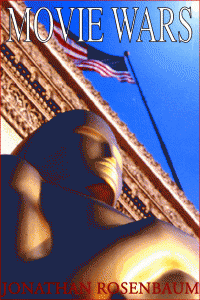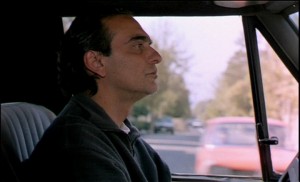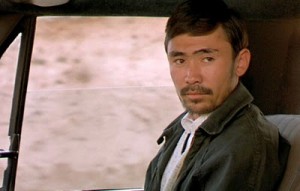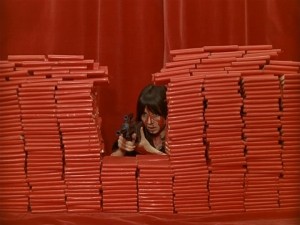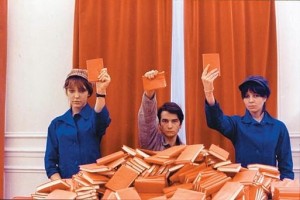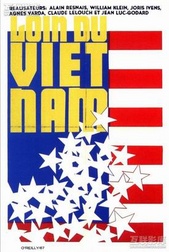The second part (roughly the second half) of Chapter One of my most popular book, Movie Wars: How Hollywood and the Media Limit What Films We Can See (2000); for the first half, go here. The illustration below is from the now out-of -print English edition. — J.R.
Is the Cinema Really Dead?
Susan Sontag’s essay “A Century of Cinema” — a generational lament whose validity for me both rests on and is partially thrown into doubt by its generational stance — has by now appeared in many languages around the world as well as in many different English-language publications, including the The New York Times Magazine (February 25, 1996), the “movie issue” of Parnassus: Poetry in Review (volume 22, nos. 1 & 2, 1997), The Guardian, and at least two book-length collections of essays. I’ve noted many interesting variations in this piece as it’s appeared in various settings, and assume that some of these represent subsequent revisions or afterthoughts on Sontag’s part. But the most striking differences appear between the first version published in America — in The New York Times Magazine, with the strikingly different title “The Decay of Cinema” — and all the others, and I assume that these, including the title, stem from editorial interventions, or at the very least collaborations between Sontag and her editor or editors at the Times.
These differences reveal a great deal about mainstream positions on the movies in general and the cinema-is-dead postulate in particular, especially as these positions become translated into editorial decisions. They expose an ideology of avoidance that I consider central to the habits of mainstream publications I have already been discussing.
Missing from the Times version were almost all of Sontag’s references to such filmmakers as Theodor Angelopoulos, Shohei Imamura, Miklós Janscó, Alexander Kluge, Nanni Moretti, Nagisa Oshima, Edgar Reitz, Aleksandr Sokurov, Hans-Jurgen Syberberg, Andrei Tarkovsky, Béla Tarr, and Krzysztof Zanussi, as well as the titles of some of their films — a virtual honor role of contemporary filmmakers whom Sontag regards as important. (In one of the later incarnations of her essay, Abbas Kiarostami’s Through the Olive Trees was added to her list of “wonderful films [that] are still being made.”) Although it appears that Sontag’s article was cut for length so that it could fit into a two-page spread, it hardly seems accidental that most of these dozen figures hadn’t curried much favor in recent years with either Times reviewers or U.S. distributors, and consequently couldn’t be counted on as familiar names to Times readers. Perhaps for the same reason, the Times version contained one sentence that can’t be found in any of the other versions: “In this country, the lowering of expectations for quality and the inflation of expectations for profit have made it virtually impossible for artistically ambitious American directors, like Francis Ford Coppola and Paul Schrader, to work at their best level.”
In other words, even in an article decrying Hollywood’s ruinous effect on world cinema, Hollywood directors had to be given more attention — and overseas directors less — when the piece was published in the Times. (Perhaps for the same reason, the names of many great non-American filmmakers of the past — including Jean Cocteau, Rainer Werner Fassbinder, Akira Kurosawa, Kenji Mizoguchi, Yasujiro Ozu, Marcel Pagnol, and Pier Paolo Pasolini — were excluded from the Times version of Sontag’s article as well.)
It reminds me of Marshall McLuhan’s account in his Introduction to Understanding Media of the “consternation of one of the editors of this book. He noted in dismay that ‘seventy-five percent of your material is new. A successful book cannot venture to be more than ten percent new.’ ” By the same standard, any article about world cinema that appears in the Times — even, and perhaps especially, a death-of-cinema article — can’t present too much new information, including unfamiliar names and film titles. That’s apparently why the frustrations and disappointments of Coppola and Schrader become ipso facto more germane to the Times’ interests than the acknowledged achievements of twenty others. Unless there’s a new commercial picture around to hawk, evidence of the death of world cinema is mainly what the Times considers fit to print; evidence of its past and present life only gets in the way of its everyday operations.
***
As I’ve already suggested, the cinema-is-dead position can at least partially be traced back to various pronouncements by Jean-Luc Godard, as well as certain assumptions embedded in much of his recent work. It should be stressed that Godard’s version of this position is a highly personal and idiosyncratic one. As the English Godard scholar Michael Witt has argued, in a conference article (2) that part of this chapter is indebted to, Godard has increasingly identified the cinema with his own life and body on the one hand and with the twentieth century on the other.
_________________________________________________________________________________
[2] “The Death(s) of Cinema According to Godard,” delivered at Screen Conference, Glasgow, Scotland, July 3, 1998, and published in Screen, vol. 40, no. 3, Autumn 1999, pp. 331–346.
Godard’s recently completed eight-part video series Histoire(s) du cinéma, which was in the works for almost a decade, is centrally concerned with the history of the twentieth century as perceived through cinema, and, conversely, with the history of cinema as perceived through the twentieth century — and both these histories are viewed as stories that are essentially over. As Witt points out, Godard’s association of both these histories with his own autobiography can be traced back to a more general impulse to “give cinema a body”: using the figure of Fritz Lang to embody classical cinema in Contempt (1963) and then filming a dialogue with Lang for French television shortly afterward entitled “The Dinosaur and the Baby”; more recently, using the figure of the American-born European actor Eddie Constantine, the star of Godard’s 1965 Alphaville, to embody cinema shortly before his death in Godard’s film Germany Year 90 Nine Zero (1991). Witt also recalls that Godard inserted himself in the same metaphor as early as Band of Outsiders (1964) by assigning himself the opening credit “Jean-Luc Cinema Godard,” and he cites many other, more recent instances of Godard “[giving] cinema a human form and life cycle” in this fashion: “If Godard, in a gesture as self-promotional and narcissistic as it is . . . has repeatedly suggested that the cinema is likely to die more or less when he does (!), then he has, for a good ten or fifteen years, exploited his own body and its physical aging as illustrative and exemplary of the winding down of cinema as an art form.”
One has to discriminate, of course, between the critical wisdom of Godard’s position and its artistic utility in his work. Just as we can distinguish the relative foolishness of Leo Tolstoy’s populist theory of history in War and Peace from the richness of the fictional world that it helps to make possible, it doesn’t help us very much to dismiss Godard’s solipsism if we fail to note some of the positive consequences it has on his art. In his interviews, moreover, Godard tends to be much less monolithic about his apocalyptic theory; when I said to him in Toronto in 1996 that one of the implications of Histoire(s) du cinéma seemed to be that the cinema was over, he was quick to add, “The cinema we knew. We also say that of painting.” [3]
__________________________________________________________________________________
[3] See “Godard in the 90s: An Interview, Argument, and Scrapbook,” Film Comment, September-October 1998.
Unfortunately, there are no such demurrals or positive consequences when Denby, Sontag, or Thomson offer equally autobiographical and self-regarding but less nuanced versions of the same position — especially because they, unlike Godard, are speaking in mainstream forums where the implications of their remarks coincide rather neatly in certain particulars with corporate interests and don’t fuel any artistic projects of comparable weight. And when mainstream commentators like Wolcott come along to challenge their doom and gloom, the counterevidence remains strictly sui generis and astutely dry-cleaned to remove any contaminating foreign influences, giving further credence to the premise that the choices made on our behalf by studios, publicists, distributors, and exhibitors are our only real possibilities.
***
Let me propose a pedagogical exercise: first reread the extended quotation from David Denby in The New Yorker, the fifth and longest of the death-of-cinema pronoucements cited at the beginning of this chapter, and then look up Denby’s dismissive review of Taste of Cherry — the first film of Iranian filmmaker Abbas Kiarostami that he bothered to see — which appeared in New York magazine the same day. In the latter, you find him writing, “I can’t help thinking that the comparisons [of Kiarostami] to De Sica and Satyajit Ray and other masters betray a degree of critical desperation. Is this movie rich enough — does it show the many-sided vitality of the great movies of the past — to warrant the extravagant praise? Or are critics, depressed by the obvious aesthetic poverty of the world cinema, arguing themselves into it, placing their bets on Kiarostami because they have no other cards to play? . . .This is a movie of great interest — an original work — but it lacks the courage, the surprise, the ravenous hunger for life, of a serious work of movie art.” To contextualize Denby’s latter statement, two recent and unproblematically “serious” works of movie art by his lights, presumably displaying courage, surprise, and a ravenous hunger for life, are Pulp Fiction and L.A. Confidential. (Personally, I would argue that both movies display at best a ravenous hunger for media that constitutes most of their surprise as well as their “courage.”)
My pedagogical exercise contains a third step: to look up the original New York reviews of films by Antonioni, Bergman, Fellini, Godard, Kurosawa, and Truffaut — the directors who, according to Denby’s New Yorker article, “defined our moods in late adolescence, [and] enlarged our sense of romance and freedom and passionate melancholy as well as the expressive possibilities of movies” — when they opened in the sixties. I’ll wager that most of them resemble Denby’s review of Taste of Cherry, showing just as much skepticism and just as little enthusiasm. How could it be otherwise, when “new” masterpieces are obliged by definition to evoke and even conform to old ones? If you’re looking for a “remnant” of former French cinema in, say, Irma Vep — a film that Denby incidentally likes because for him it exposes the bankruptcy of contemporary French cinema — then the very idea of a French film addressing the nineties rather than the sixties is ruled out-of-order. So it’s only logical that Kiarostami, who was already making films throughout the seventies without Denby’s interest or awareness, has to be measured against a sixties reading of De Sica or Satyajit Ray rather than against a nineties reading of anything. (We have to bear in mind that during Denby’s alleged Golden Age, films from Iran, China, Taiwan, Africa, and most of the remainder of the so-called Third World weren’t even being seen in the West, much less considered, and what we were seeing from Japan, Russia, eastern Europe, and Latin America was extremely limited.) The fact that I happen to find Kiarostami a great deal more interesting and important than either De Sica or Ray is virtually beside the point. Denby, who isn’t remotely interested in catching up on any of the two decades of Kiarostami’s work that preceded Taste of Cherry, is asking for a time-tested and culturally authenticated master to be made apparent on the basis of a single feature. And if the cultural authorities who deemed De Sica and Ray masters didn’t familiarize themselves with Kiarostami’s earlier work, presumably it must be Kiarostami who’s to blame.
When Denby complains that “it’s hard to scare up much of an audience for” La Cérémonie in 1996, the implication is that New York audiences in the sixties were storming the art theaters to see L’avventura, Shoot the Piano Player, Shame, Fellini Satyricon, High and Low, and La Chinoise, which clearly wasn’t the case. Most of them were flops with limited support from mainstream critics, and if Denby was bucking the establishment back then and deciding for himself that they were major “mood-defining experiences,” it would be interesting to learn more of the circumstances of such encounters. Speaking for myself, I took a bus all the way from New York to Philadelphia on March 23, 1968, when I was twenty-five, to see La Chinoise at a film club screening two weeks prior to its New York opening, when it ran for just a single week. Part of the reason why I went to such lengths was that Godard was scheduled to appear with the film in Philadelphia; in fact he never turned up, but I never regretted making the trip as a consequence. In fact, when I boarded the bus I discovered that a cinephile friend from college was making the same trip for the same reason. When we boarded the bus back to New York a few hours later, he bought a copy of the Sunday New York Times to bring with us, and I’ll never forget finding there a lengthy irate letter to the editor written by me a few weeks earlier, defending Godard’s films against charges of arbitrariness and lack of structure as propounded by the late Eugene Archer (incidentally the major mentor of Andrew Sarris, and ironically one of the first American champions of la politique des auteurs, which subsequently became mutated through Sarris’s efforts into what became known as “the auteur theory”). “[Godard’s] most recent films,” I concluded in my letter, “are simultaneously investigations into and lessons about how to see, hear and understand our everyday existence. Regardless of how one ultimately judges them, it is irresponsible to call them frivolous; far more frivolous is the critical intelligence which refuses to grapple with them.”
It’s also worth adding that during the week’s run of La Chinoise that started at New York’s Kips Bay Theater on April 3, my friends and I went to see it more than once. Some of these friends were attending Columbia University at the time, and when the campus was taken over by students a short time later, I couldn’t help but think that Godard’s film had inspired and influenced their militancy. Maybe part of this was wishful thinking, but maybe not: word of mouth traveled more quickly in those days — faster than The New York Times, faster even than television — because there was less media to compete with. Not that the media didn’t exist, but it was believed in much less by people of my and Denby’s generation; all one had to do was read — or, on television, see — the reports of the demonstrations we participated in, against the Vietnam war and on behalf of civil rights, in order to understand that the truth of what happened was available only from fellow demonstrators and other members of the counterculture, not from the “official” channels. And the same thing was true when it came to finding out about movies: the David Denbys and the Eugene Archers of the sixties were not the authorities one had to turn to.
Admittedly, by waxing nostalgically as well as egotistically about such a period, I’m potentially fostering the same argument of generational entitlement and narcissistic authority that Denby, Sontag, and Thomson set forth. But my argument differs from theirs in my conviction that the legacy of the sixties is not quite as dead as they —and Godard, for that matter — assume. And to account for this conviction, I paradoxically need to cite a film that’s even more forgotten today than La Chinoise: Far from Vietnam — a collectively made piece of French agitprop about the war that was concurrently waged by the United States in southeast Asia.
The directors involved in this episodic feature were Godard, Joris Ivens, William Klein, Claude Lelouch, Alain Resnais, and Agnès Varda, and the editing was carried out collectively in Paris under the supervision of Chris Marker. (4) The film premiered at the New York Film Festival in 1967, which was where I first saw it; I recall the controversial press screening, punctuated by much booing as well as applause. It carried an enormous emotional value for me at the time, in spite of the unequalness of its parts, because of its strong feeling of interconnection — the conviction that you could still say something important about an American war in Vietnam when your base of operations happened to be France. Around this period I had already become acquainted with the work of five of the seven filmmakers who contributed to this feature —Godard, Resnais, Lelouch, Marker, and Varda, but not yet with Ivens or Klein. Yet it was probably Klein who affected me the most when he focused on how an American Quaker, Norman Morrison, following the example of several South Vietnamese Buddhist monks, protested the war by burning himself alive in Washington, D.C.
__________________________________________________________________________________
[4] Anecdotal and historical aside: when I met Marker for the first time at the Festival of the Midnight Sun in Finland in June 1998, he recalled that the protracted editing of Far from Vietnam — which took so long because it was carried out collectively — was carried out at Antégor, the same Paris editing studio where Orson Welles put together F for Fake a few years later.
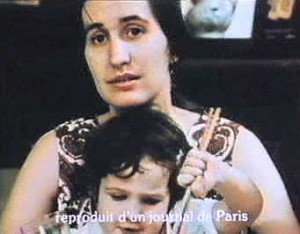
Like many, perhaps most Americans at the time, I already knew who Morrison was and what he had done, but all I had heard about his act from friends and colleagues was that he was a madman whose suicide had accomplished nothing. What Klein, an American expatriate in Paris, had shown me was that what Morrison had done meant a great deal, not only to his own family, but also to the North Vietnamese, who had even named a street after him. These were simple facts, but nothing I had come across in American journalism at the time had made them available. Consequently, the importance of this information — like the importance of all the new films that mattered most to me in the mid-sixties — wasn’t part of the media as I understood it then, but part of something else. It was like receiving a letter from friend who lived far away but knew exactly what I was thinking. That’s still what matters most to me in movies, and the major legacy of the sixties for me is the certainty that there are still friends of this kind scattered across the globe, regardless of the state of our postal delivery.
It’s the state of our postal delivery, cinematically speaking, that most of the remainder of this book will be concerned with. The insistence that there’s no longer a great deal of mail worth delivering or receiving apart from the bills and advertising fliers that we can already count on is for me the bottom line of all the end-of-cinema manifestos, and the reason why these arguments need to be interrogated so closely.
***
Perhaps the most categorical of all these doomsday manifestos is the one voiced by Gilbert Adair in the Preface to his recent British collection Surfing the Zeitgeist — that all contemporary art without exception is in a state of precipitous decline. Decrying “the persistent and concerted stroking of our national ego, as though it went without saying that ours was one of the Golden Ages of artistic endeavour,” Adair provides the following counterblast:
Briefly, about that Golden Age. The louder the hyperbole, the more vociferous the self-trumpeting, the harder it becomes to credit that anyone is truly taken in (even among the trumpeters themselves —Salman Rushdie, for one). I offer no counterargument here, as it would be a waste of both time and space, the naming of names being all that is really needed. So, to cast the net no further back than to the last of the genuine cultural Golden Ages, the first fifty years of this century, I name: Picasso, Mondrian, Matisse, Kandinsky, Stravinsky, Debussy, Bartok, Schoenberg, Proust, Joyce, Kafka, Mann, Rilke, Yeats, Brecht, Pirandello, Genet, Chaplin, Ozu, Dreyer, Vigo. I could go on, as I am sure the reader could (for there are innumerable more where these came from), but it would be as pointless an exercise as would be pitiful any attempt to match such names from the past with those of supposedly comparable creators from the present. Only an idiot or an opportunist or a congenital optimist would dare to suggest that ours is anything but a period of profound cultural mediocrity and stagnation. That is neither an insight nor an idea but an inescapable fact. [5]
___________________________________________________________________________________
[5] London: Faber and Faber, 1997, pp. ix–x.
Unlike the hand-wringing of Denby, Thomson, Sontag, and even Godard, this uncharacteristically links what’s happening in film to what’s happening in the other arts, something that Sontag herself did cogently and innovatively in the sixties. It’s certainly enough to give one pause, because Adair’s honor roll of twenty-one names from the first half of the twentieth century does seem hard to top.
Yet if we consider only the four filmmakers who conclude that list, something crucial becomes immediately apparent. Apart from Chaplin, recognized throughout most of the century as a major artist — discounting that period near midcentury when he was hounded out of this country and denied reentry because of his leftist sympathies, his sexual behavior, and the bad impression left by Monsieur Verdoux, one of his greatest films — the other three filmmakers remain esoteric at best to most American moviegoers, and their greatness was far from recognized even among many specialists until well after their deaths.
Let’s take them in order. Although Yasujiro Ozu (1903–1963) was celebrated in Japan throughout much of his career, he remained unknown in the West (apart from Japanese movie houses on the West Coast and in Hawaii) until Tokyo Story (1953), which surfaced in the United States at the University of California film festival in 1956. Even after that, screenings of his work in the West were so rare and sporadic that when the first Ozu retrospective at the Cinémathèque Française — much of which I attended — played in 1972, it was the first prolonged exposure to his work that most Parisian cinephiles had, and most American film buffs had to wait much longer. Even today, though all of his surviving features are available on video in Japan, only half a dozen of these are available in the United States, and this doesn’t include any of his silent films [6] — a rich and strikingly different part of his oeuvre comprising thirteen surviving features made between 1929 and 1935 (as well as a short documentary and twenty-odd more films that are either lost or survive only in fragments). Even in Japan, it would be a gross exaggeration to say that his surviving work is known in any detail; when I participated in an Ozu symposium in Tokyo in late 1998, many of the film scholars I met there had not seen several of his key pictures, including most of the silent ones.
___________________________________________________________________ [6] Happily, as this book went to press, I Was Born, But . . . , perhaps the greatest of Ozu’s silent features, was released by New Yorker Films.
Carl Dreyer (1889–1968), born in Sweden and raised in Denmark, is even less well known in the United States than Ozu. From the sound period onward, all of Dreyer’s features were commercial flops practically everywhere they showed, and I think it would be fair to call him the artist in Adair’s list of twenty-one whose works have been hardest to access, with the possible exception of Pirandello. [2014 note: Roughly fifteen years after this sentence was written, when I was still on the cusp of the digital revolution, I can happily report that this is no longer even remotely true; thanks to DVDs and Blu-Rays, all of Dreyer’s major works are now available, and in excellent editions., so I’m immensely pleased by how dated the remainder of this paragraph is today.] Some of his masterpieces are completely out of reach (apart from unsubtitled prints at New York’s Anthology Film Archives), and others have been available only in abysmal prints that barely hint at their richness. One of the greatest, Day of Wrath (1943), is a film I only started to appreciate in any detail after I was able to see a new print in Paris in the late eighties; prior to that, neither the sound nor the image was adequately discernible in the battered 16-millimeter prints I had seen, and since then — until Home Vision Cinema recently brought out a gorgeous video version — the only way I was able to return to it in a watchable form was on a French video, playable only on a tristandard VCR (which is itself a pretty scarce item in this country). Happily, Home Vision Cinema has also just brought out comparably exquisite video versions of Dreyer’s two final features, Ordet (1955) and Gertrud (1964), so thirty-two years after his death, his late work is finally becoming available in some form — though I can’t vouch for how widely available these videos are. (Over the past couple of decades, whenever I’ve been asked to pick my “all-time” favorite film, my usual response depends almost entirely on which of these three Dreyer masterpieces I’ve seen last.) And when it comes to silent masterpieces like The Parson’s Widow (1920) and Mikael (1924), the chances of encountering them in any form nowadays are pretty slim. Fortunately, Master of the House (1925), The Passion of Joan of Arc (1928), and Vampyr (1932) are somewhat easier to come by, at least on video, and the restored, original version of the second has also surfaced recently on film and video alike. Whether or not this will lead to a belated recognition of Dreyer’s genius in some quarters depends almost entirely on the word getting out.
Jean Vigo (1905–1934) only lived long enough to make four films, and only one of these (the 1934 L’Atalante) is long enough to qualify as a feature; fortunately, a restoration of that film in the early nineties received enough play to make this work more available in recent years than anything by Ozu or Dreyer. But his equally great Zéro de conduite (Zéro for Conduct, 1933) probably remains known today chiefly by film students. And prior to the restoration of L’Atalante, the story of the reception of his work is mainly a protracted nightmare: most of it was banned, mangled beyond recognition, and/or marginalized while he was alive, then buried for years afterward. The original U.S. premieres of both Zéro de conduite and L’Atalante weren’t until 1947.
What’s the point of rehashing all these hard-luck stories? Simply to point out that if the major works of three of the four names cited so confidently by Adair remained inaccessible for decades, and remain so to most people today, what about the major works of filmmakers who have emerged during the second half of the twentieth century, some of whom Adair might not have encountered or even heard of yet? Or better yet, if we accept his hypothesis that world art has been in overall decline for the past half century — based on the premise that, unlike our predecessors, we’re fully in a position to know what’s around — when are most people going to get a proper opportunity to see all of the great films made during the previous fifty years, even just those on his admittedly abbreviated short list?
I’m reminded of the pipe dream of the late Carlos Clarens, a Cuban-born film buff and critic who spent most of his adult years in Paris and New York — perhaps the two cities in the world where one can see the greatest number of important films, new as well as old. Carlos used to fantasize that one year the studios would fail to release a single new movie and would instead be forced to revive all the unseen and unseeable glories they had locked up in their vaults. Similarly, if the decline in world cinema is as serious as Denby, Thomson, Sontag, Adair, and others insist it is, then we could still catch up on all the wonders that they and we have missed — and revive the great works that never fully made the rounds.

